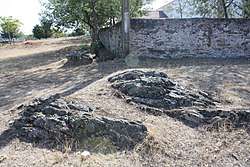Castro de Sacóias
The Castro of Sacóias (Portuguese: Povoado Fortificado de Sacóias/Castro de Sacóias) is a former fortified settlement and archeological site in the civil parish of Baçal, municipality of Bragança in the Alto Trás-os-Montes subregion of the Portuguese Norte Region.[1]
Castro of Sacóias Castro de Sacóias Fortified Settlement of Sacóias | |
|---|---|
 | |
| Etymology: Sacóias | |
| Coordinates: 41°51′47.26″N 6°41′24.84″W | |
| Country | Portugal |
| Region | Norte |
| Subregion | Alto Trás-os-Montes |
| District | Bragança |
| Municipality | Bragança |
| Elevation | 680 m (2,230 ft) |
| Management | Instituto Gestão do Patrimonio Arquitectónico e Arqueológico |
| Operator | Câmara Municipal de Torres Vedras |
| Status | National Monument Monumento Nacional |
| Listing | Decree 16 June 1910; DG136, 23 June 1910 |
History
It is likely that the site was constructed during the Iron Age, and restructured over time.[1] It was occupied by Roman settlers during the Roman occupation of the Iberian peninsula.[1]
During the second half of the 18th century, the then-existing religious temple was moved from the Castro to the main settlement, to substitute an older chapel, then housing a baptismal fountain and conserving the Blessed Sacrament.[1]
The Castro, and group of existing structures, are of individual importance that resulted in it being designated a National Monument in 1910, as well as a structure of municipal interest by the council of Bragança.[1]
Architecture
The site is located on an isolated, rural hilltop rising over the Chapel of Nossa Senhora da Assunção.[1] It consists of a destroyed fortified settlement, with small walls constructed with small stones, in addition to remnants of tiles, bricks and millstones.[1] Most of the artefacts unearthed from the site was collected by the Sociedade Martins Sarmento, and presented at the Municipal Museum of Bragança and Archaeological Museum.[1]
References
Notes
- Jana, Ernesto (1993), SIPA (ed.), Povoado Fortificado de Sacóias (IPA.00000552/PT010402040001) (in Portuguese), Lisbon, Portugal: SIPA –Sistema de Informação para o Património Arquitectónico, archived from the original on 6 March 2016, retrieved 30 December 2015
Sources
- Fernandes, Armando; Rodrigues, Luís Alexandre (2004), Monografia das Freguesias do Concelho de Bragança (in Portuguese), Bragança, Portugal: Câmara Municipal de Bragança
- Lopo, Albino dos Santos Pereira (1987), Apontamentos Arqueológicos (in Portuguese), Braga, Portugal